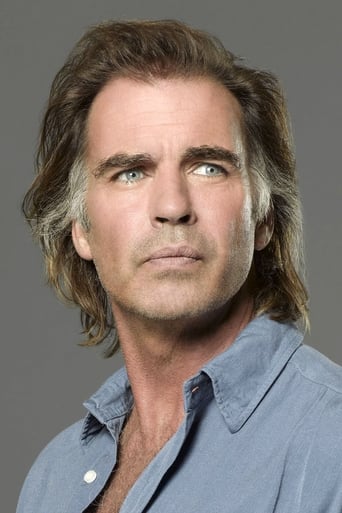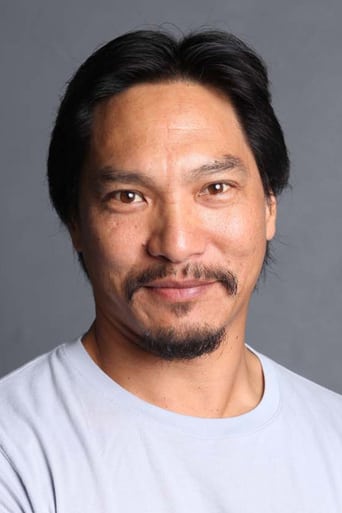Scanialara
You won't be disappointed!
ThiefHott
Too much of everything
Intcatinfo
A Masterpiece!
InformationRap
This is one of the few movies I've ever seen where the whole audience broke into spontaneous, loud applause a third of the way in.
Bambikilled
I really wanted to like this movie, even though seeing the bad reviews and grades, but I'm sorry to say I just couldn't. Already in the first scene,(incense and cultural clichés accompanied by ramblings), I was thinking "Nooo". Cheesy and conceited were adjectives that came to mind...I'm very interested in military history, especially WWII. I have my roots in Finland, and therefore I have the same relationship to Finnish movies about the Winter war and Continuation war (btw something to take a look at for anyone interested in WWII, to see some of the least discussed but most astonishing military wonders of all times - a tiny Little poorly equipped army in a tiny little country, literally crushing the USSR Bear), as I suppose Asian Americans have to this movie, since it portrays a part of the US Army which seldom have gotten any recognition for their efforts and sacrifice. (Also see "Days of glory", a rather good movie about the Algerian French soldiers in the French army during WWII - Another "forgotten" Group).I also have a great interest and fair insight into different Asian cultures due to both personal interest and having several Asian in-laws in the family. Also, some of the areas in WWII history, which I have spent the most time on, are the affairs in Asia and the Pacific. So the genuine interest is there, and also a good insight and knowledge of actual history.Still, I have to practically force myself through this syrupy mess... The degree of melodrama, over acting and oh-it's-so-sad, is so extensive that it makes me queasy. Everything is shoved in the face of the viewer, in a pathetically naïve way, leaving no room for any thought or reflexion. Nothing is subtle nor actually touching, since the director has drenched it all in banality and cheap clichés.The acting is horrible and over dramatic overall, and leaves one with an uncomfortable feeling of embarrassment on the behalf of both the actors and the characters. They are all flat and one-dimensional, delivering predictable portraits with no depth. I would even say that the characters, in a way, mock and ridicule Asian Americans, and place the whole group in an old and clichéd POV. Which is both sad and frustrating.The depiction of battle and warfare is badly acted, but mainly badly planned and executed by the director, giving an air of boys playing war at a paint-ball field, rather than actually being at the western front. Low budget is not an excuse since many movies pull it off anyway.The script is annoying in it's throws hence and forth, and in it's lack of continuity and a red thread. The scenes don't drive the story forwards, but just seem random and confused. Dialogue is mostly bad.Overall, this movie is a crappy mess with not much good to be said about. And that's irritating since this forgotten part of WWII-history is a very interesting one, and a movie made by a good director, with a good script and screenplay, with good actors, could have made it a see worthy pearl of a flick, instead of a pathetic puddle of syrup. :( I can't even recommend it to anyone except maybe descendants of the Asian American soldiers from the US troops of WWII. I think they could have some kind of benefit from this Movie, otherwise, it's mostly a waste of time. See something good instead.Sad to say, because I so much would have wanted to like this.But Lane Nishikawa kind of fu*ed up. Seriously badly so.
narasaki9
This is a terrific film and tribute to an unbelievable group of soldiers and just one of their amazing accomplishments. With all the renewed interest in World War II as this generation of men begin to pass from the scene, I can't believe there haven't been more films about the little- known exploits of this all-Japanese American 442nd RCT. As of this writing, this film has mainly been on the film festival circuit - I can't believe this was a low-budget, independent film - a period piece, and a war picture, to boot. A great cast, including such Asian American luminaries like Jason Scott Lee, Mark Dacascos, Tamlyn Tomita, Pat Morita (maybe his last performance), and others, along with a scrupulous attention to detail - weapons, uniforms, etc. - make this a stand-out film. The script's basic theme - that each of these men were more than just soldiers, they each had families, loved ones, reasons to live - magnify the tragedy of each death, so this film not only honors and glorifies these men's accomplishments, it also serves as a meditation on the true cost of war. Hope this sparks many, many more films about these guys!
BradBate
Historians at the Army Center for Military History in Washington struggled for words to describe what happened. It was October 30, 1944. Members of the segregated Japanese-American 442nd Regimental Combat Team, "cold, wet, weary and battle-scarred," rescued 211 Texas National Guardsmen who were surrounded by German forces in the foggy, wooded Vosges Mountains near Bruyeres, France. The First Battalion, 141st Infantry Regiment had been cut off from food, ammunition, communications and hope for a week. The 442nd, comprised of Nisei (a person born in America of parents who emigrated from Japan) from Hawaii and the West Coast of the United States was ordered in when two other battalions of the 141st had been repelled repeatedly by the enemy. After three days of devastating battle, nearly half the Japanese-American troops were dead or wounded and the "Lost Battalion" was still trapped."Then, something happened in the 442nd," according to the military historians. "By ones and twos, almost spontaneously and without orders, the men got to their feet and, with a kind of universal anger, moved toward the enemy position. Bitter hand-to-hand combat ensued as the Americans fought from one fortified position to the next. Finally, the enemy broke in disorder." It is this story that is at the heart of "Only the Brave," Writer/Director Lane Nishikawa's very personal film of uncommon courage, misguided prejudice and family love now playing at the Hawaii International Film Festival. It is Nishikawa's final film in a trilogy ("Sound of a Voice," 2003; "Forgotten Valor," 2001) dealing with the experience of Japanese-Americans in the Second World War. The multi-talented auteur, who has performed in a number of films but is best known as a stage actor and director, had four uncles and other extended family members who served in the 442nd or the earlier 100th Infantry Battalion (formed as the Hawaiian Provisional Battalion).Instead of taking the wide-angle battle scene approach of a Wolfgang Peterson ("Troy"), Ridley Scott ("Kingdom of Heaven"), Oliver Stone ("Alexander') or even Steven Spielberg ("Saving Private Ryan"), Nishikawa has narrowed his focus to the points of view of his own small "band of brothers." Included in that number are Sergeant Jimmy Takata, played with grace and wisdom by the director, Glenn "Tak" Takase (Jason Scott Lee), Richard "Doc" Naganuma (Ken Narasaki), Steve "Zaki" Senzaki (Mark Dacascos), Yukio "Yuk" Nakajo (Yugi Okumoto) and Richard "Hilo" Imamura (Garett Sato). These are men who cannot see beyond their own 30mm eyes, the trees, darkness and fog that surround them, and the flares of machine guns and bursts of grenades that pound relentlessly. "Up close and personal" sounds a little trite, but that's what we get. Nishikawa shows us war just the way a soldier sees war.He also shows us, through flashbacks, the personal side of the war on the home front. "Doc" Naganuma's wife and baby awaiting his return in an internment camp where 110,000 persons of Japanese ancestry (70,000 of whom were native-born United States citizens) sat out the war in conditions not much better than POWs. Mary Takata's (Tamlyn Tomita) struggle to reach her shell-shock husband after the peace. The mothers and fathers, wives and children whose one consolation was that their soldier-loved ones were among friends. (The dialogue is realistically grounded in the Pidgin English common to Hawaii-born people, and the banter between the soldiers sounds like something you would hear among a group of guys having a beer after work in a Wahiawa, Hawaii tavern.) The film is not without its flaws, some of them a function of the production's limited budget. It is in desperate need of a stronger score, powerfully executed with a more dynamic sound design. I saw a digital projection that needed sophisticated color correction; that can come when film prints are ultimately struck. I wish Nishikawa could re-shoot some of his early battle scenes. They are stiff and dated in their appearance as opposed to his footage later in the film when he had a stronger sense of self-confidence in getting the camera off its tripod and moving with it in a more documentary style. Watching your own dailies can be a major growing experience.But it is a powerful and sensitive piece of work that should be seen by far more than just the California school kids who use the director's earlier films as part of their history curriculum.Those of us who live in Hawaii understand the context of this film. Our neighbors include survivors of the 100th/442 RCB, their children, grandchildren and great grandchildren. In Hawaii, where the war began for America, these men are revered. School kids can tell you of their exploits. Senator Daniel K. Inouye is recognized as much for his Congressional Medal of Honor as for his 46 years in the Congress. Sergeant Inouye was awarded the Bronze Star for his actions in the "Lost Battalion" campaign, lost ten pounds and gained a battlefield commission. Later, back in Italy, his heroism earned him one of 20 Medals of Honor conferred on 100/442 soldiers.There should be no more respected a group of senior citizens in America than the veterans of the "Purple Heart Battalion." In eight major campaigns, they were also awarded seven Presidential Unit Citations and 18,143 individual decorations (no, that is not a typographical error; 18,143 individual medals), including 52 Distinguished Service Crosses. In that number, of course, were 9,486 Purple Hearts, for that was the total of the injuries they suffered in combat.This is not the first film focused on the 100th/442 RCB. Van Johnson starred in 1951's "Go For Broke," a filmed titled after the motto of the battalion. In it he played Lt. Mike Grayson, who trained a Nisei platoon. The black and white film was heavily focused on Grayson, who loses his prejudices when he sees how the Japanese Americans fight in combat.
dmao
I was privileged to be able to see this movie @ a screening put on by the filmmaker @ The Majestic Theatre in Seattle Washington. This movie was very eye-opening for anyone that hasn't experienced or looked into the Japanese during the time they were put into internment camps.There are some great action scenes but also slow scenes... they all intermix and show the lives of the people fighting in an American War. I thought this movie was very moving and touching but very slow at some points where the point was made and needed to move on. The acting in this movie was great and at some points, I almost shed a tear because the movie was so touching. I would recommend this movie to anyone willing to learn about cultural differences between Americans and Japanese-Americans.





